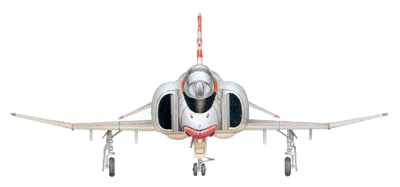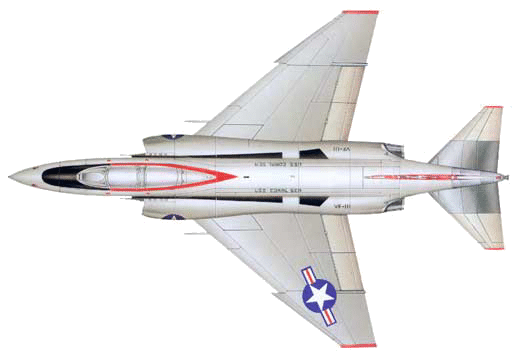|

McDonnell F-4B Phantom
Unanimously recognized as the best
fighter-bomber ever built, the F-4 Phantom II was designed in 1953 with a
view to providing the US Navy with an all-weather supersonic twin-jet
capable of combining speed, manoeuvrability, bomb-load capacity, weight
and power. No easy task, but the McDonnell designers succeeded
brilliantly; when on May 27, 1958, the first prototype (F4H-1) took to the
air, its qualities were so obvious that the US Navy chose it in preference
to its direct rival, the LTV F8U-3 Crusader III, ordering its
mass-production. The first basic version, designed for shipboard use by
the US Navy and the Marines, was the F-4B (first flight March 25, 1961),
and 649 of these planes were delivered up to 1967. In addition to the many
variants adopted by the USAF, the US Navy took 522 of a second version,
the F-4J Phantom II (first flight May 1966). In Vietnam the F-4s were
first sent into action from the aircraft carrier USS Constellation on
August 5, 1964.
Unquestionably the leading role in the
air war in Vietnam was played by the McDonnell F-4 Phantom, which was used
by the US Navy and the US Marine Corps in the B and J versions, and by the
USAF in different versions. The earliest arrivals in the Southeast Asia
theatre of operations were the F-4Bs of the VMFA-531, on April 11, 1965.
They were followed by those of many other Marine squadrons, based on land,
and by squadrons of the US Navy operating from aircraft carriers. It would
be unfair to single out the exploits of any particular unit because such a
list would fill the pages of a sizeable book and because all distinguished
themselves both in the attack/bombing role and in their demonstration of
aerial supremacy. During direct encounters with the enemy, F-4Bs and F-4Js
shot down 55 MiGs, of which eighteen were MiG-21s, two MiG-19s and the
rest MiG-17s. Even so, it is fitting to mention the name of the US Navy
Commander Randall H. 'Duke' Cunningham, and of his radarman, Lieutenant
William P. 'Willie' Driscoll, with one MiG-21 and four MiG-17s to their
credit, and to point out that the squadron boasting the biggest number of
enemy planes downed was the VF-96, with eight certain victims and two
probables. From the moment they went into action until the last day of the
war, the Navy and Marine Phantoms never let up, gaining a reputation that
they were later to emulate in other parts of the world.



Technical Specifications
Aircraft:
McDonnell F-4B
Year: 1961
Type: fighter-bomber
Manufacturer: McDonnell Aircraft Corp.
Engine: 2 x General Electric J79GE-8A
Power: 17,000 lb (7,711 kg)
Wingspan: 38ft 5in (11.70m)
Length: 58ft 3 3/4in (17.78m)
Height: 16ft 3in (4.95m)
Wing area: 530sq ft (49.23mē)
Max take-off weight: 44,600 lb (20,231 kg)
Empty weight: 28,000 lb (12,70l kg)
Max speed: 1,485mph at 48,000ft (2,390km/h at 14,630m)
Service ceiling: 62,000ft (18,898m)
Range: 400mi (644km)
Crew: 2
Load-armament: 6-8 missiles; 16,000 lb (7,275 kg)
|
